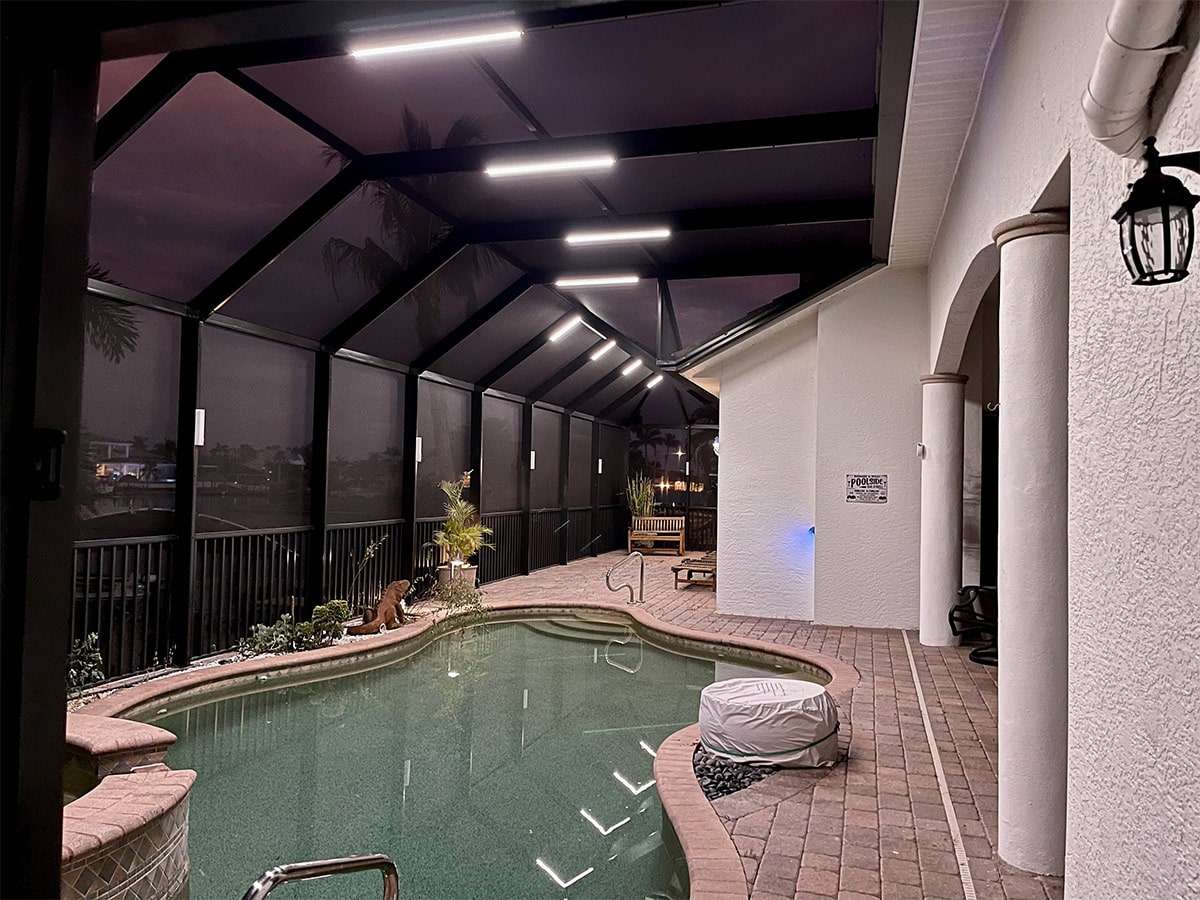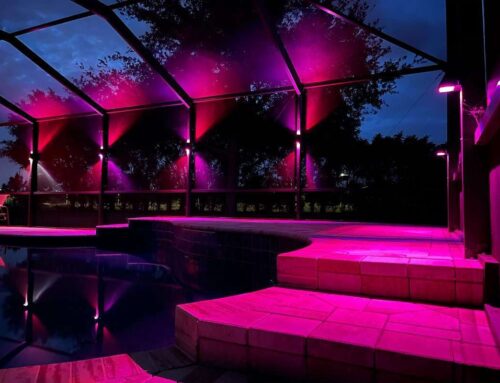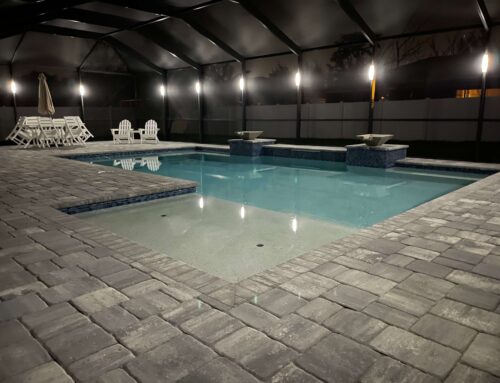
Optimizing Pool Lighting in Southwest Florida for a Bug-Free Experience: A Detailed Overview
Southwest Florida, with its balmy evenings, is perfect for enjoying a tranquil poolside setting. The distinct charm of pool lighting in this region, however, often attracts an unwanted swarm of bugs. This presents a challenge for many homeowners. Whether you’re considering cage lighting, outdoor lights, or are intrigued by the possibilities of low voltage lights and screen enclosure lights in Southwest Florida, the right choice can make a significant difference.
Beyond just enhancing the aesthetic appeal of your pool, the right lighting choice plays a pivotal role in determining whether your evening is filled with the soothing glow of lights or the constant flutter of bugs. This guide delves deep into the world of pool lighting in Southwest Florida, offering invaluable insights to help homeowners strike the right balance between beauty, functionality, and a bug-free environment.
Understanding the Science
To make an informed decision about pool light colors, it’s essential to understand why bugs are attracted to lights in the first place.
How Bugs Perceive Light:
Insects, especially nocturnal ones like moths, use natural light sources such as the moon and stars to navigate. These celestial bodies provide a constant angle of light, aiding bugs in maintaining a straight path. Artificial lights, like those in our homes and pools, confuse these insects. They end up circling the light source, mistaking it for the moon or stars, leading them to become trapped or hover around them.
Why Certain Colours Attract or Repel Bugs:
The light spectrum visible to us is also visible to most bugs, but not in the same way. Many insects see ultraviolet (UV) light, which is invisible to the human eye. Lights that emit a strong UV component or have a blue or white hue are highly attractive to bugs. On the other hand, yellow, orange, or red lights, which emit a minimal UV component, are less enticing to these pests. These colours either blend into the background or are less distinguishable for many insects, making them less of a magnet compared to cooler toned lights.
Understanding this science not only helps in choosing the right pool light color but also in appreciating the broader role lights play in the natural world and the life of insects. As we proceed, we’ll delve into the specific colours that are both aesthetically pleasing and efficient at keeping bugs at bay.
The Spectrum of Pool Light Colors
A pool’s allure in the evening isn’t just about its shimmering water but also the colour of its light. The choice of pool light colours has evolved over the years, with technology enabling a range from serene and subtle to vibrant and dynamic. Before we identify which colours are best at deterring bugs, let’s explore the spectrum of available pool light hues and the ambiance each creates.
Overview of Available Pool Light Colors:
- White: The classic choice, offering clear visibility and a neutral, elegant ambiance.
- Blue: A popular colour that gives pools a tropical or oceanlike feel.
- Green: Evokes a natural, lagoonstyle appearance.
- Red: Bold and energising, often used for special occasions or themes.
- Purple: Tranquil and slightly mystical.
- Yellow: Warm, inviting, and reminiscent of a sunset.
- Colourchanging: Modern LED lights can transition between various colours, setting dynamic moods.
Pros and Cons of Each Colour in Terms of Aesthetics and Bug Attraction:
- White: While timeless and bright, it can attract a significant number of bugs due to its higher UV emission.
- Blue: Moderately attractive to insects, balancing between aesthetics and functionality.
- Green: Less enticing for bugs, especially when it’s a deeper shade.
- Red: Least visible to many insects, making it a top choice for bug deterrence.
- Purple: Attracts fewer bugs than blue or white but more than red or yellow.
- Yellow: Offers one of the best solutions for minimizing bug attraction while still illuminating your pool.
- Colourchanging: While versatile, it might attract bugs when transitioning through blue or white shades.
These are the Best Colors to Prevent Bugs
The colour spectrum of pool lights doesn’t just impact aesthetics; it can also affect the number of bugs you see hovering around your pool area. After extensive research and observations, some colours have proven more effective in deterring bugs than others. Here’s a breakdown:
- Yellow: Many bugs see light differently than humans, and yellow hues tend to be less visible to them. A warmer, yellowish light won’t attract as many bugs as cooler colours.
- Warm White: Unlike the bright, bluish-white lights, a warmer white emits less UV light, which means fewer bugs. It offers a soothing ambiance without becoming a beacon for insects.
- Orange and Pink: Similar to yellow, these warmer hues also tend to deter bugs better than cooler colours. They can be an excellent choice for those looking for something different than traditional whites and blues.
- Red: While not always the first choice for pool lighting due to its intense appearance, red is the least visible colour to many bugs. If you’re planning a late-night swim and bug activity is at its peak, switching to a red hue can help.
It’s worth noting that while these colours can deter bugs, no light will make your pool 100% bug-proof. However, opting for one of these hues can significantly reduce the number of unwanted flying guests.
Common Misconceptions
Over the years, several myths and misconceptions surrounding pool lights and bugs have taken root in popular discussions. Unravelling these misconceptions can help pool owners make more informed decisions and set realistic expectations.
- All Pool Lights Attract Bugs Equally: As we’ve discussed, the colour and type of light make a significant difference. Blue and white lights tend to attract more bugs than warmer hues like yellow or red.
- Brighter Lights Repel Bugs: On the contrary, brighter lights often attract more insects, especially if they emit higher UV components. The key lies in choosing the right colour and intensity balance.
- Only the Light’s Colour Matters: While colour plays a significant role, factors like brightness, surrounding vegetation, and even water movement can influence bug attraction.
Considering the Aesthetic Factor
While functionality is paramount, the aesthetic appeal of pool lights remains a top concern for many homeowners. After all, your pool is a central feature of your outdoor space, and its lighting can set the mood for evening gatherings and events.
- Balancing Functionality with Design: It’s entirely possible to select a pool light colour that both deters bugs and enhances the ambiance. For instance, a soft yellow or red can create a warm, inviting atmosphere while keeping bugs at bay.
- Trends in Pool Light Design: Modern pools increasingly incorporate dynamic lighting options, such as LEDs that change colours or synchronise with music. For those keen on embracing these trends while deterring bugs, it’s advisable to set colour transitions to favour warmer hues during peak insect activity times.
Installation Tips
Ensuring the optimal performance of your pool lights is not just about selecting the right colour; it’s also about proper installation and positioning.
- How to Properly Install Pool Lights: Ensure that the light fixtures are sealed correctly to prevent water infiltration. Engaging a professional can guarantee both the safety and efficiency of the installation.
- Ensuring Maximum Effectiveness Against Bugs: Positioning is key. Aim to install lights in a way that their glow covers the pool but doesn’t unnecessarily illuminate surrounding vegetation, which can attract more bugs. Consider using lights with dimming capabilities, allowing you to reduce brightness during peak bug activity times without compromising on visibility.
- Pairing with Other Deterrents: Think of your pool light as one element in a broader bugdeterrence strategy. Surrounding your pool with plants that naturally repel bugs or installing bug zappers at a distance can complement the effectiveness of your chosen pool light colour.
Up next, we’ll explore the essentials of maintaining your pool lights and delve into alternative strategies to maintain a bugfree pool environment.
Alternative Solutions to Keep Bugs Away
While pool lights play a role in bug attraction or deterrence, there are several other methods pool owners can adopt to ensure a bugfree environment:
- Natural Repellents: Planting bugrepellent plants like citronella, lavender, or marigold can reduce the number of bugs in your pool area.
- Bug Zappers: Strategically placed away from the pool, they can trap and eliminate bugs. Ensure they’re a bit distanced from the pool so they don’t attract bugs directly over the water.
- Water Movement: Features like fountains or waterfalls create ripples that deter bugs from landing on the water surface.
- Fans: Outdoor fans can provide a gentle breeze that prevents many flying insects from approaching.
- Chemical Repellents: While they can be effective, ensure any repellents used are safe for pool environments and won’t harm the water quality.
Cost Implications
The cost of maintaining a bugfree pool environment varies based on the methods and tools employed:
Pool Lights: Opting for LED lights might have a higher initial cost, but their energy efficiency and lifespan can offer savings over time.
- Natural Repellents: Growing repellent plants is a costeffective method. However, regular gardening and maintenance costs should be considered.
- Bug Zappers: Depending on the brand and size, zappers can range from affordable to pricey. They also consume electricity, adding to operational costs.
- Water Features: Installing waterfalls or fountains can be an upfront investment. Maintenance and increased water circulation can add to operational expenses.
- Fans and Chemical Repellents: Fans have an initial cost and operational electricity costs. Chemical repellents have recurring expenses but can be effective in the short term.
Conclusion
Creating a bugfree pool environment is a blend of choosing the right lighting, strategic placement, and incorporating additional deterrence methods. While there are costs associated with each method, the benefits of a comfortable and bugfree swimming experience often outweigh the investments. Pool owners should evaluate their specific needs, budget, and environment to determine the best combination of strategies. With thoughtful planning, it’s entirely feasible to enjoy serene evening swims without the constant annoyance of bugs.

